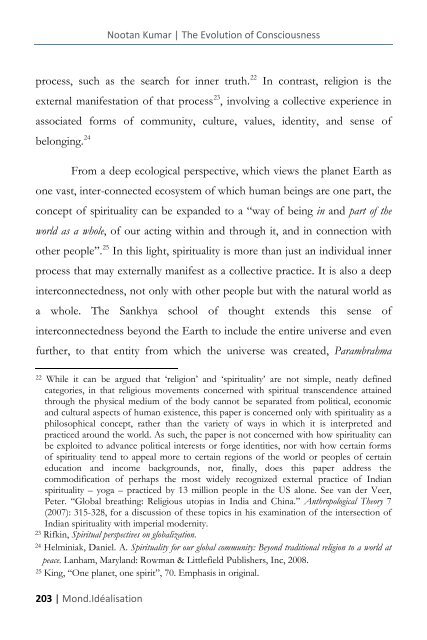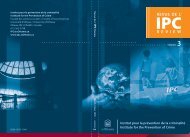GLOB.IDEALIZATION MOND.IDÉALISATION - Faculty of Social ...
GLOB.IDEALIZATION MOND.IDÉALISATION - Faculty of Social ...
GLOB.IDEALIZATION MOND.IDÉALISATION - Faculty of Social ...
You also want an ePaper? Increase the reach of your titles
YUMPU automatically turns print PDFs into web optimized ePapers that Google loves.
203 | Mond.Idéalisation<br />
Nootan Kumar | The Evolution <strong>of</strong> Consciousness<br />
process, such as the search for inner truth. 22 In contrast, religion is the<br />
external manifestation <strong>of</strong> that process 23 , involving a collective experience in<br />
associated forms <strong>of</strong> community, culture, values, identity, and sense <strong>of</strong><br />
belonging. 24<br />
From a deep ecological perspective, which views the planet Earth as<br />
one vast, inter-connected ecosystem <strong>of</strong> which human beings are one part, the<br />
concept <strong>of</strong> spirituality can be expanded to a “way <strong>of</strong> being in and part <strong>of</strong> the<br />
world as a whole, <strong>of</strong> our acting within and through it, and in connection with<br />
25<br />
other people”. In this light, spirituality is more than just an individual inner<br />
process that may externally manifest as a collective practice. It is also a deep<br />
interconnectedness, not only with other people but with the natural world as<br />
a whole. The Sankhya school <strong>of</strong> thought extends this sense <strong>of</strong><br />
interconnectedness beyond the Earth to include the entire universe and even<br />
further, to that entity from which the universe was created, Parambrahma<br />
22 While it can be argued that ‘religion’ and ‘spirituality’ are not simple, neatly defined<br />
categories, in that religious movements concerned with spiritual transcendence attained<br />
through the physical medium <strong>of</strong> the body cannot be separated from political, economic<br />
and cultural aspects <strong>of</strong> human existence, this paper is concerned only with spirituality as a<br />
philosophical concept, rather than the variety <strong>of</strong> ways in which it is interpreted and<br />
practiced around the world. As such, the paper is not concerned with how spirituality can<br />
be exploited to advance political interests or forge identities, nor with how certain forms<br />
<strong>of</strong> spirituality tend to appeal more to certain regions <strong>of</strong> the world or peoples <strong>of</strong> certain<br />
education and income backgrounds, nor, finally, does this paper address the<br />
commodification <strong>of</strong> perhaps the most widely recognized external practice <strong>of</strong> Indian<br />
spirituality – yoga – practiced by 13 million people in the US alone. See van der Veer,<br />
Peter. “Global breathing: Religious utopias in India and China.” Anthropological Theory 7<br />
(2007): 315-328, for a discussion <strong>of</strong> these topics in his examination <strong>of</strong> the intersection <strong>of</strong><br />
Indian spirituality with imperial modernity.<br />
23 Rifkin, Spiritual perspectives on globalization.<br />
24 Helminiak, Daniel. A. Spirituality for our global community: Beyond traditional religion to a world at<br />
peace. Lanham, Maryland: Rowman & Littlefield Publishers, Inc, 2008.<br />
25 King, “One planet, one spirit”, 70. Emphasis in original.

















